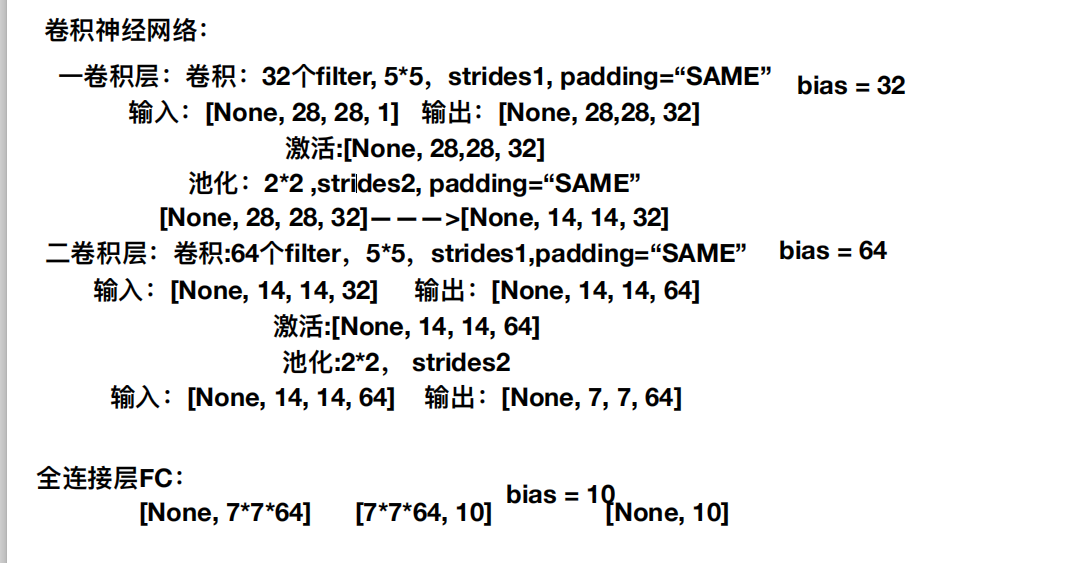卷积网络的结构为:

代码:
# coding=utf-8
import tensorflow as tf
from tensorflow.examples.tutorials.mnist import input_data
def weight_variable(shape):
"""
权重初始化函数
:param shape:
:return:
"""
weight = tf.Variable(tf.random_normal(shape,seed=0.0,stddev=1.0))
return weight
def bias_variable(shape):
"""
偏置初始化函数
:param shape:
:return:
"""
bias = tf.Variable(tf.random_normal(shape, seed=0.0, stddev=1.0))
return bias
def model():
"""
定义卷积网络模型
:return:
"""
# 1、准备数据
with tf.variable_scope("pre_data"):
x = tf.placeholder(tf.float32,[None,784])
y_true = tf.placeholder(tf.int64,[None,10])
# 2、定义第一层卷积网络
# 卷积层为:[5*5*1] 大小的过滤器,有32个,步长为1
# 池化层为 [2*2] 大小的,步长为2
with tf.variable_scope("conv1"):
# 卷积层输入的格式为[batch,heigth,width,channel],所以x的形状需要修改
x_reshape1 = tf.reshape(x,[-1,28,28,1])
# 初始化过滤器,为[5*5]大小的,设置32个
filter1 = weight_variable([5,5,1,32])
bias1 = bias_variable([32])
# 卷积层定义,将数据变为[None,28,28,32]
x_jjc1 = tf.nn.conv2d(input=x_reshape1,filter=filter1,strides=[1,1,1,1],padding="SAME")
# 激活层
x_relu1 = tf.nn.relu(x_jjc1) + bias1
# 池化层,将数据[None,28,28,32] 变为 [None,14,14,32]
x_pool1 = tf.nn.max_pool(x_relu1,ksize=[1,2,2,1],strides=[1,2,2,1],padding="SAME")
# 3、定义第二层卷积网络
# 卷积层为[5*5*32],64个,步长为1
# 池化层为[2*2],步长为2
with tf.variable_scope("conv2"):
# 定义第二个卷积层的过滤器
filter2 = weight_variable([5,5,32,64])
bias2 = bias_variable([64])
# 卷积层定义,将数据变为[None,14,14,64]
x_jjc2 = tf.nn.conv2d(input=x_pool1,filter=filter2,strides=[1,1,1,1],padding="SAME")
# 激活层
x_relu2 = tf.nn.relu(x_jjc2) + bias2
# 池化层,将数据变为[None,7,7,64]
x_pool2 = tf.nn.max_pool(value=x_relu2,ksize=[1,2,2,1],strides=[1,2,2,1],padding="SAME")
# 4、定义全连接层
with tf.variable_scope("fc"):
# 定义权重和偏置
weight = weight_variable([7 * 7 * 64 ,10])
bias_fc = bias_variable([10])
x_pool2_reshape = tf.reshape(x_pool2,[-1,7*7*64])
# 预测值
y_predict = tf.matmul(x_pool2_reshape,weight) + bias_fc
return x,y_true,y_predict
def convolution():
mnist = input_data.read_data_sets("../data/day06/",one_hot=True)
# 1、定义模型
x,y_true,y_predict = model()
# 3、模型参数计算
with tf.variable_scope("model_soft_corss"):
# 计算交叉熵损失
softmax = tf.nn.softmax_cross_entropy_with_logits(labels=y_true, logits=y_predict)
# 计算损失平均值
loss = tf.reduce_mean(softmax)
# 4、梯度下降(反向传播算法)优化模型
with tf.variable_scope("model_better"):
tarin_op = tf.train.GradientDescentOptimizer(0.0001).minimize(loss)
# 5、计算准确率
with tf.variable_scope("model_acc"):
# 计算出每个样本是否预测成功,结果为:[1,0,1,0,0,0,....,1]
equal_list = tf.equal(tf.argmax(y_true, 1), tf.argmax(y_predict, 1))
# 计算出准确率,先将预测是否成功换为float可以得到详细的准确率
acc = tf.reduce_mean(tf.cast(equal_list, tf.float32))
# 6、准备工作
# 定义变量初始化op
init_op = tf.global_variables_initializer()
# 定义哪些变量记录
tf.summary.scalar("losses", loss)
tf.summary.scalar("acces", acc)
merge = tf.summary.merge_all()
# 开启会话运行
with tf.Session() as sess:
# 变量初始化
sess.run(init_op)
# 开启记录
filewriter = tf.summary.FileWriter("../summary/day08/", graph=sess.graph)
for i in range(1000):
# 准备数据
mnist_x, mnist_y = mnist.train.next_batch(50)
# 开始训练
sess.run([tarin_op], feed_dict={x: mnist_x, y_true: mnist_y})
# 得出训练的准确率,注意还需要将数据填入
print("第%d次训练,准确率为:%f" % ((i + 1), sess.run(acc, feed_dict={x: mnist_x, y_true: mnist_y})))
# 写入每步训练的值
summary = sess.run(merge, feed_dict={x: mnist_x, y_true: mnist_y})
filewriter.add_summary(summary, i)
return None
if __name__ == '__main__':
convolution()
结果为:
